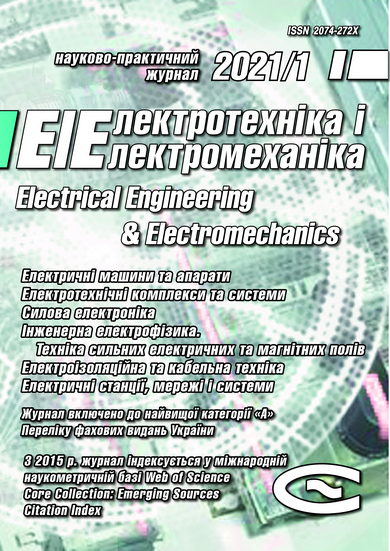Synthesis of constructive-technological decisions of regulation of working capacitance of cables of industrial networks
DOI:
https://doi.org/10.20998/2074-272X.2021.1.07Keywords:
industrial networks, twisted pair, insulated conductor, foaming, insulation thickness, effective dielectric constant, electrical capacitanceAbstract
Introduction. Over the past 10 years, the number of industrial networks has more than doubled. At the physical level, all industrial technology networks are based on twisted pair. Purpose. Synthesis of constructive-technological decisions of regulation of electric capacitance of the insulated conductor at a stage of manufacturing of twisted pair of cables of industrial networks. Methodology. The method of secondary charges to determine the capacitance of the insulated conductor by varying the thickness of the solid and foamed polyethylene insulation. Practical value. Effective regulation is provided on the basis of the obtained dependencies of the effective dielectric constant, the tangent of the dielectric loss angle and the capacitance of the insulated conductor on the degree of foaming and the thickness of the protective film of two-layer insulation. At a degree of porosity of 40 %, the dielectric constant decreases by 25 %, the tangent of the dielectric loss angle – by 33 %, the electrical capacitance of the insulated conductor – by 20 %.
References
Pigan R., Metter M. Automating with PROFINET: Industrial Communication Based on Industrial Ethernet. John Wiley & Sons Publ., 2015. 462 p.
Bezprozvannych G.V., Pushkar O.A. Increasing noise immunity of cables for fire protection systems. Electrical Engineering & Electromechanics, 2020, no. 4, pp. 54-58. doi: https://doi.org/10.20998/2074-272x.2020.4.07.
Belous A., Saladukha V. High-Speed Digital System Design: Art, Science and Experience. Springer Nature Publ., 2019. 933 p.
International Standard ISO/IEC 11801. Information Technology – Generic cabling for customer premises. Part 2: Office premises. 2017. 24 p.
Semenov A. Advanced Twisted Pair Cables for Distributed Local Area Networks in Intelligent Structure Systems. IOP Conference Series: Materials Science and Engineering, 2018, vol. 317, p. 012053. doi: https://doi.org/10.1088/1757-899x/317/1/012053.
Penttinen Jyrki T.J. The Telecommunications Handbook: Engineering Guidelines for Fixed, Mobile and Satellite Systems. John Wiley & Sons Publ., 2015. 1008 p.
Sending all the right signals. White paper. Single pair Ethernet in the Industrial Field. Belden, 2020. 8 p.
Bezprozvannych G.V., Ignatenko A.G. Optimization of the design of network cables by the attenuation coefficient in the tolerance zone of the geometric dimensions of the transmission parameters. Electrical Engineering & Electromechanics, 2004, no. 2. pp. 8-10. (Rus).
Iossel Yu.Ya., Kochanov E.S., Strunsky M.G. Raschet elektricheskoi emkosti [Calculation of electrical capacity]. Leningrad, Energoizdat Publ., 1981. 288 p. (Rus).
Levin B.M. Calculation of Electrical Parameters of Two-Wire Lines in Multiconductor Cables. IEEE Transactions on Electromagnetic Compatibility, 2008, vol. 50, no. 3, pp. 697-703. doi: https://doi.org/10.1109/temc.2008.927924.
Vishnyakov E.M., Khvostov D.V. Calculation of inter-wire inductance and capacitance of symmetric straight pairs by methods of conformal mappings and finite elements. Cable-news, 2007, no. 3 (13), pp. 30-36. (Rus).
Boyko AM, Bezprozvannych G.V. Justification of insulation thickness of twisted shielded pairs of structured cable systems. Bulletin of NTU «KhPI», 2011, no. 3, pp. 21-35. (Ukr).
Bezprozvannych G.V. Comparative analysis of the transverse structure of unfilled and filled telephone cables based on capacity and dielectric dissipation measurement results. Electrical Engineering & Electromechanics, 2007, no. 5, pp. 61-66. (Rus).
Sikora Technology to Perfection / Capacitance 2000. Available at: https://sikora.net/en/products/capacitance2000/ (Accessed 14.09.2020).
Zumbach Electronics. CAPAC® / FFT / SRL – Overview. Available at: https://www.zumbach.com/ru/products/product-finder/capac-fft-srl/capac-overview.html (Accessed 14.09.2020).
Xu Z., Xue P., Zhu F., He J. Effects of formulations and processing parameters on foam morphologies in the direct extrusion foaming of polypropylene using a single-screw extruder. Journal of Cellular Plastics, 2005, vol. 41, no. 2, pp. 169-185. doi: https://doi.org/10.1177/0021955x05051740.
Pinto J., Notario B., Verdejo R., Dumon M., Costeux S., Rodriguez-Perez M.A. Molecular confinement of solid and gaseous phases of self-standing bulk nanoporous polymers inducing enhanced and unexpected physical properties. Polymer, 2017, vol. 113, pp. 27-33. doi: https://doi.org/10.1016/j.polymer.2017.02.046.
Palchykov O.О. Determination of the effective permittivity of a heterogeneous material. Electrical Engineering & Electromechanics, 2020, no. 2, pp. 59-63. doi: https://doi.org/10.20998/2074-272x.2020.2.09.
Downloads
Published
How to Cite
Issue
Section
License
Copyright (c) 2021 G.V. Bezprozvannych, I.A. Kostiukov, O.A. Pushkar

This work is licensed under a Creative Commons Attribution-NonCommercial 4.0 International License.
Authors who publish with this journal agree to the following terms:
1. Authors retain copyright and grant the journal right of first publication with the work simultaneously licensed under a Creative Commons Attribution License that allows others to share the work with an acknowledgement of the work's authorship and initial publication in this journal.
2. Authors are able to enter into separate, additional contractual arrangements for the non-exclusive distribution of the journal's published version of the work (e.g., post it to an institutional repository or publish it in a book), with an acknowledgement of its initial publication in this journal.
3. Authors are permitted and encouraged to post their work online (e.g., in institutional repositories or on their website) prior to and during the submission process, as it can lead to productive exchanges, as well as earlier and greater citation of published work.





